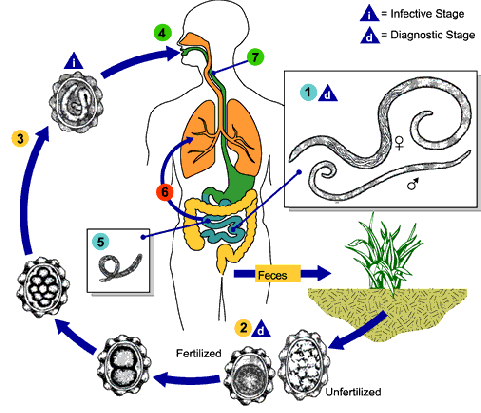Ascaris are parasitic worms in the intestines of various terrestrial animals, chiefly herbivores. They are typically large worms characterized by a mouth surrounded by three lips. The species Ascaris lumbricoides is probably the most familiar parasite in humans. An almost identical worm, often called A. suum, occurs in pigs.
The intestinal roundworm Ascaris lumbricoides infection in humans follows the ingestion of Ascaris eggs that have contaminated foods or soil. In the small intestine the larvae are liberated and migrate through the intestinal wall, reaching the lungs, where they may produce a host sensitization that results in lung inflammation and fluid retention. About 10 days later, the larvae pass from the respiratory passages into the digestive tract and mature into egg-producing worms, which grow to some 15 to 40 cm (6 to 16 inches) in length, in the small intestine. Serious, even fatal, complications of ascariasis result from the infiltration of the larvae into sensitive tissues, such as the brain, and from the migration of the adult worms into various body structures where they produce abcesses and toxic manifestations.
Ascariasis exists worldwide and is believed to affect some 660 million persons.
Life Cycle Diagram (Courtesy of the DPD)

Adult worms
 live in the lumen of the small intestine. A female may produce up to 240,000 eggs per day, which are passed with the feces
live in the lumen of the small intestine. A female may produce up to 240,000 eggs per day, which are passed with the feces
 . Fertile eggs embryonate and become infective after 18 days to several weeks
. Fertile eggs embryonate and become infective after 18 days to several weeks
 , depending on the environmental conditions (optimum: moist, warm, shaded soil). After infective eggs are swallowed
, depending on the environmental conditions (optimum: moist, warm, shaded soil). After infective eggs are swallowed
 , the larvae hatch
, the larvae hatch  , invade the intestinal mucosa, and are carried via the portal, then systemic circulation to the lungs
, invade the intestinal mucosa, and are carried via the portal, then systemic circulation to the lungs
 . The larvae mature further in the lungs (10 to 14 days), penetrate the alveolar walls, ascend the bronchial tree to the throat, and are swallowed
. The larvae mature further in the lungs (10 to 14 days), penetrate the alveolar walls, ascend the bronchial tree to the throat, and are swallowed
 . Upon reaching the small intestine, they develop into adult worms
. Upon reaching the small intestine, they develop into adult worms
 . Between 2 and 3 months are required from ingestion of the infective eggs to oviposition by the adult female. Adult worms can live 1 to 2 years.
. Between 2 and 3 months are required from ingestion of the infective eggs to oviposition by the adult female. Adult worms can live 1 to 2 years.

